|
gada
(गदा)
Sanskrit. A club or mace, one
of Vishnu's attributes and the main weapon of many a yak (giant).

Gajagaranaka
Sanskrit-Pali. 'One resembling
an elephant'. A name for
Ganesha.

Gajamuk
Pali. 'With the face of an
elephant'. A name for
Ganesha.

gajasingha
Pali. A mythological lion with
the head of an elephant. Its name is a compound of gaja (elephant) and
singha (lion). There are two kinds which in Thai have different names:
one is called kodchasih, the other takkatoh. The difference between the
two is that the takkatoh has a goatee and furry hair on the top of its
head.

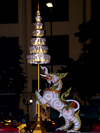
gandhabbas
Pali for
gandharvas.

Gandhara (गन्धार)
Indian art style that developed
during the Kushan period, from the first to second centuries AD. It is
distinguished by depictions of the Buddha with realistic features,
wearing draped robes, reflecting Greek influence.

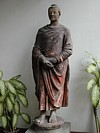
gandharattha (गन्धरत्थ)
Sanskrit. A mudra 'calling upon
the rain' with the right hand, whilst the left hand is held at the waist
forming a bowl to 'collect the rainfall'. This mudra is usually found
with statues from the Rattanakosin period. Also gandhararath.

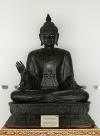
gandharvas (गन्धर्व)
Sanskrit. Male half-gods and
celestial musicians who in Hindi mythology are accompanied by the female
apsaras. They are the guardians of the soma. Generally considered aerial
spirits who live in the firmament and reveal the Divine Truth in the
form of a celestial rain. In Pali called gandhabbas.

Gandiva (गांडीव)
Sanskrit. Magical bow that
Arjuna received as a reward for helping Agni and Krishna burn down
Khandava forest.

Ganesha (श्रीगणेश)
Sanskrit. 'Lord of hordes', a
compound name made up of and the word gana, meaning 'horde' and isha
meaning 'lord' or 'ruler'. Son of Parvati, consort of Shiva. He was
created by Parvati from the flakes of her skin mixed with oil, and
brought to life with water from the Ganges. He is represented with a
human body and the head of an elephant, with one tusk broken off (Ekatanta).
His mount is the rat. According to legend he was decapitated during one
of Shiva's tantrums, who promised a new head from the first creature
that he would encounter - it turned out to be a baby elephant. His
broken tusk is a souvenir from the event when the rat, tired of carrying
him, threw him off. The moon who witnessed this laughed mockingly and
Ganesha in anger broke off his tusk and threw it at the moon. He is the
protector of art, remover of obstacles, and the god of knowledge and
intelligence, and of transition and new beginning. In his terrible form
he represents the underworld. In Thailand he is also called Phra Kaneht
and Phra Phikhanesawora, and is worshipped as the deity who improves
fortune in trade. He is honored with Motaka, sweets and fruit, when
business is good, and he is made ridiculous by putting his picture or
statue upside down, when business is down.

_small.jpg)
Ganga (गङ्गा)
Sanskrit. Goddess personifying
the river Ganga or Ganges in India. She is one of two daughters of the
sacred golden mountain Meru, the other being Uma or Parvati, consort of
Shiva. Her symbol is the makara. The river Ganges is considered sacred
by Hindus, with healing and other holy properties. It has the recursive
property that any water mixed with even the minutest quantity of Ganga
water becomes Ganga water, which is so holy that even the greatest of
sins may be washed away by bathing in it. Initially Ganga resided in the
Heavens, but king Bhagiratha of Kosala, seeking to find salvation for
his ancestors who were cursed by the sage Kapila, persuaded her to come
down to Earth to wash out the sins of the humans and make the whole
earth virtuous and fertile. To break Ganga's fall on her descend to
Earth, she had to come through the jata, the matted hair, of the god
Shiva. See also
Ganga and
Jahnavi.

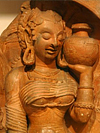
Ganga
(गंगा)
Hindi for
Ganga.

Ganges
River in India considered
sacred by Hindus. In mythology it is personified by the goddess Ganga,
in Thai called Khongkha. Also nicknamed celestial river. See also Ganga.

Garuda (गरुड)
Sanskrit. A large and savage
mythological bird, mount of the Hindu god Vishnu, with enough size to
block out the sun and wings that create hurricane-like winds that darken
the sky and chant the Vedas when flying. He is the king of birds, a son
of Kasyapa and Vinata, whose sister was Kadru, the mother of serpents,
thus making him a half-brother of the nagas and snakes. However, in a
bid to liberate his mother Vinata, who had become enslaved to her sister
after losing a imprudent bet, he became the arch-enemy of the serpents.
He is depicted with a golden body of a human and the wings and feet of a
bird, and the beak of an eagle. He has a white face and a crown on his
head and is in art often shown in battle with a snake or naga. His birth
and actions are told in the first book of the epic Mahabharata, where it
is written that when he first hatched, he appeared as a raging inferno
equal to the cosmic blaze that consumes the world at the end of every
yuga. Frightened, the gods begged for mercy, whereupon Garuda reduced
himself in size and force. In the Vedas, where he is mentioned the first
time, he is said to have brought nectar from heaven to earth. In
Hinduism, worship of Garuda is believed to remove the effects of poisons
from one's body. Krishna carries the image of Garuda on his banner and
in Thailand, where Garuda is called Krut, he is the nation's royal
symbol, showing the connection between the Thai monarch as the protector
of the nation, and the mighty god Vishnu as the protector of the
universe. Garuda has six sons from whom the race of birds descended. In
Buddhism garudas are huge and intelligent predatory birds with social
order, and believed to dwell in silk cotton trees. Also known by the
names Chirada, Gaganeshvara, Galon, Kamayusha, Karura, Kashyapi,
Khageshvara, Khangard, Nagantaka, Shyena (eagle), Sitanana, Sudhahara,
Suparna or Supanna (well-winged), Tarkshya, Vainateya, Vineeta,
Vishnuratha (chariot of Vishnu), etc.

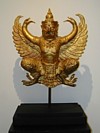
Gautama (गौतम)
Sanskrit. 'The best ox'.
Patronymic or family name of the historical Buddha usually used in texts
to refer to the Buddha before he attained Enlightenment. He is the
fourth of five great teacher-buddhas and was born in the region of
present day India and Nepal. His full name as the prince of the Shakya
clan is Siddhartha Gautama, son of Suddhodana Gautama. Also spelled
Gotama.

Gautami
Sanskrit. The sister of prince
Siddhartha's mother, who became Siddhartha's guardian when his mother
died, seven days after his birth. She later married his father
Suddhodana. Also known as Maha Prajapati.

geomancy
1. Chinese art of divination by
lines and figures, used to determine the correct placing of objects and
buildings. See also
feng shui.
2. Prophecy by drawing lines in earth or sand.

ghanta
Sanskrit. A bell, sometimes
held in the hand of a deity. Its sound symbolizes existence, and as an
attribute of the Hindu god Shiva it is a symbol of creation. In Buddhism
it may represent wisdom.

Ghost
Month
See
Gui Yue.

golden lotus
Lotus that grows from the navel
of Vishnu during his cosmic sleep and from which Brahma emerges. Also a
metaphor in Buddhism and often represented in art and Thai temples.

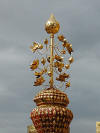
Gopa
(गोपा)
Sanskrit. The wife of prince
Siddhartha Gautama, also called Yashodhara.

gopis
(गोपी)
Sanskrit. Milkmaids, or female
cowherds, who played with Krishna in his childhood. When they gathered
on the banks of the river Yamuna to dance and flirt, each of them
thought she was alone with Krishna, but in fact he multiplied himself
and danced with them all.

Gosiya (โกศิยะ)
Thai name of a very rich but
stingy man who lived during the time of the Buddha and loved eating
kanom beuang pancakes. To avoid having to share them with anyone he
would ask his wife to make the sweets in a hidden place, so he could eat
all by himself. When the Buddha found out about the man's behaviour he
sent Mogallana to visit Gosiya during his bintabaat alms round and told
him to beg for kanom beuang as an alms offering. Gosiya, although
unwillingly, couldn't decently refuse the monks request thus came up
with the idea to offer only a very small pancake. However, each time his
wife put the dough onto the baking plate it swell until it had the size
of the hot plate itself. After several attempts to make just a small
kanom beuang, he gave up his efforts and eventually became a generous
man.

gong
de (功德)
Chinese. 'Merit heart'. Term
for a kind of tamboon (merit making) ritual in which next of kin offer
paper paraphernalia to their dead. It is commonly practiced at
Thai-Chinese funerals. The paper paraphernalia may include paper
mansions, paper cars, paper mobile phones, paper gold bars, Chinese gold
ingots made from paper and other materialistic goods, as well as fake
paper money known as hell money (ming bi) and joss or gold paper (jin
zhi). All these are burned in specially built ovens on the last night
before the coffin is cremated or buried, for the use of the departed in
the afterlife. The ritual may also be observed on the 7th or 21st day
after the death of a person, during Qing Ming, Chinese All Souls Day and
during Ghost Month, the seventh Chinese lunar month. The ritual is also
intended to make it easier for mourners to come to terms with their
grieve. Before burning joss paper the person offering it will first make
a vow called athitahn, in which the hands are brought together above the
head, making a wai. From Thai transliterated as kong teik.

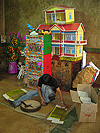
Gotama
See Gautama.

Govardhana
Sanskrit. 'Increaser of
cattle'. The mountain lifted by the Hindu god Krishna to shelter the
herdsmen and their cattle from the storm caused by Indra, after they had
refused to make offerings to him and instead became followers of
Krishna.

Govinda (गोविन्द)
Sanskrit. 'Cowherd', one of the
epithets of Krishna.

Great Departure
The moment when prince
Siddhartha at the age of twenty-nine left his family and renounced his
royal life to become an ascetic in order to find the cause of human
suffering. In Thai known as Nih Banpacha, literally: 'depart to live as
a monk'.

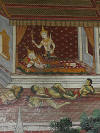
Great Renunciation
The silent and sad farewell of
prince Siddhartha to his wife, baby son and his royal heritage, in order
to become an ascetic.

Guan
Yu (关羽)
Chinese name for Kuan U.

guishe
(龟蛇)
Chinese for 'tortoise-snake'.

Gui
Yue (鬼月)
Chinese. 'Ghost Month'. Name of
a Chinese festival that coincides with the seventh Chinese lunar month
in which the deceased come out from the lower world and visit the
living, whereas on Qing Ming the living pay homage to their ancestors by
tending to their graves. During this month and especially on the
thirteenth day which is called Ghost Day, Chinese Buddhists perform
rituals to transmute and absolve the sufferings of the deceased by
offering food and burn gong de paper paraphernalia and/or hell money.
Other festivities may include releasing lanterns on water, similar to
those on Loi Krathong. Also known as Zhong Yuan Jie.

Guo
Nian (过年)
Chinese. 'Pass the year'. Name for the first day of Chinese New Year.
Also Xin Nian, literally 'New Year' and Chun Jie, 'Spring Festival'.

guru
(गुरु)
Term from Sanskrit meaning
'spiritual leader' and 'teacher'.
 |